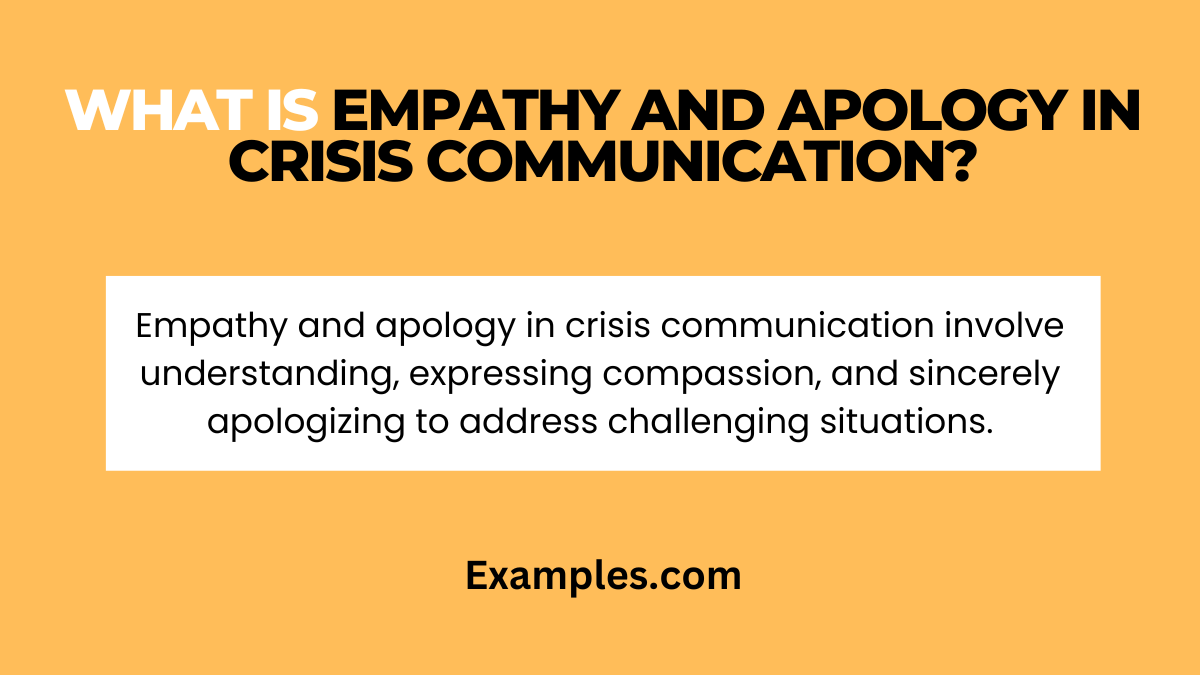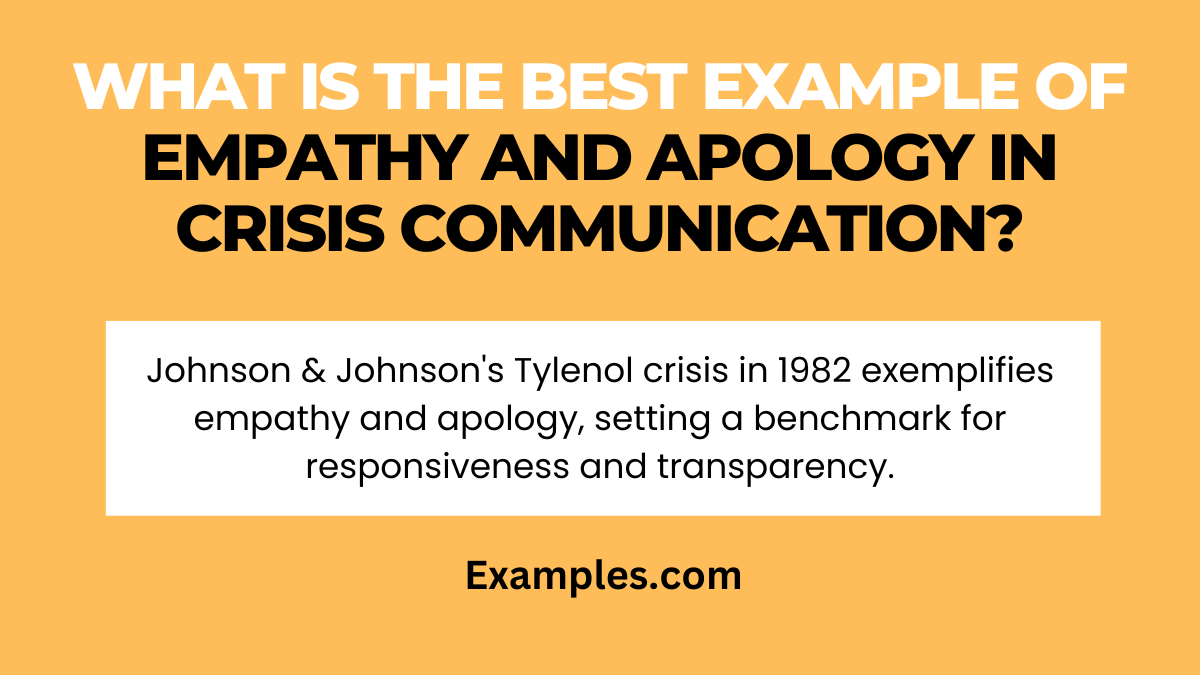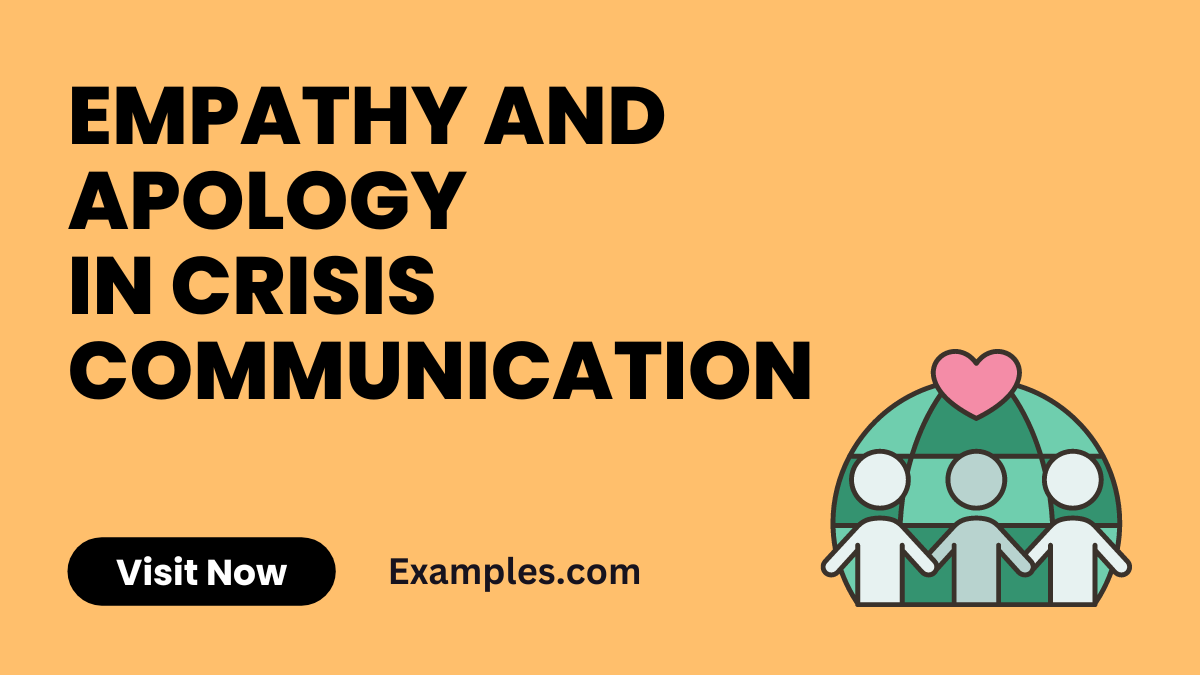19+ Empathy and Apology in Crisis Communication Examples
Navigating crises requires finesse, and mastering Empathy and Apology in Crisis Communication is paramount. This comprehensive guide unveils real-world instances, invaluable tips, and practical strategies, ensuring you wield these crucial tools effectively. Dive into the nuances of conveying genuine empathy and crafting sincere apologies during challenging times. Elevate your crisis communication with actionable insights and expert advice, framed with a focus on Communication Examples that illuminate the path to resilience and reputation management.
What is Empathy and Apology in Crisis Communication?

Empathy and apology are pivotal elements in crisis communication, representing the acknowledgment of pain or inconvenience experienced by stakeholders. Empathy involves recognizing emotions, while apology expresses regret for any harm caused. In crises, these components form a compassionate response strategy, fostering trust and goodwill. A genuine apology coupled with empathetic gestures not only addresses immediate concerns but also lays the foundation for rebuilding relationships and safeguarding organizational reputation.
What is the Best Example of Empathy and Apology in Crisis Communication?

In 1982, Tylenol faced a crisis when cyanide-laced capsules led to multiple deaths. Johnson & Johnson’s swift and empathetic response set a benchmark. The company immediately recalled 31 million bottles, halted production, and cooperated with authorities. CEO James Burke took responsibility, expressed genuine remorse, and introduced tamper-evident packaging. This empathetic and apologetic approach not only prioritized public safety but also showcased a commitment to transparency, accountability, and consumer welfare. The incident remains a case study in effective crisis communication.
20 Empathy and Apology in Crisis Communication Examples

In crisis scenarios, expressing empathy and offering sincere apologies is paramount. For instance, if a product defect leads to inconveniences:
- Product Recall Impact: Express heartfelt regret, acknowledging inconvenience caused. Apologize sincerely and outline steps taken to rectify the issue.
- Service Disruption Acknowledgment: Show understanding for disruptions. Apologize genuinely and offer compensations or alternatives to make amends.
- Data Breach Communication: Address concerns with empathy, apologize for the breach, and reassure affected parties with proactive security measures.
- Supply Chain Challenges: Acknowledge delays, empathize with frustrations, and provide transparent updates while assuring steps are taken for improvement.
- Public Relations Crisis Response: Apologize for any misleading information, express understanding, and clarify with accurate details to regain trust.
- Health and Safety Concerns: In a health crisis, empathize with fears, apologize for any shortcomings, and communicate preventive measures and support.
- Environmental Impact Apology: Express regret for environmental issues, apologize sincerely, and outline sustainable practices for future mitigation.
- Financial Service Crisis: Show empathy for financial losses, apologize for any disruptions, and communicate corrective measures and compensation.
- Employee Crisis Communication: Acknowledge employee concerns during crises, apologize for uncertainties, and communicate supportive measures.
- Brand Image Crisis Response: Apologize for any harm to the brand, express understanding, and communicate corrective actions to rebuild brand trust.
- Social Media Backlash Management: Acknowledge criticism, apologize for any offense, and engage positively with a commitment to better communication.
- Transportation Service Crisis: Express understanding for travel disruptions, apologize sincerely, and communicate corrective actions for improved services.
- Educational Institution Crisis: Acknowledge disruptions, apologize for inconveniences, and communicate measures taken to ensure a stable and secure learning environment.
- Community Relations Crisis: Empathize with community concerns, apologize for any negative impact, and engage in collaborative solutions for improvement.
- Telecommunication Service Outage: Acknowledge service disruptions, apologize sincerely, and communicate immediate actions and long-term improvements.
- Pharmaceutical Product Recall: Express empathy for health concerns, apologize for any risks, and communicate steps taken to ensure product safety.
- Entertainment Industry Crisis: Acknowledge disappointments, apologize for any disruptions, and communicate plans to address concerns and enhance experiences.
- Government Crisis Communication: Express empathy for public concerns, apologize for any shortcomings, and communicate transparent measures for improvement.
- Retail Industry Crisis Response: Acknowledge customer inconveniences, apologize sincerely, and communicate compensatory actions and enhanced services.
- Technology Service Interruption: Empathize with user frustrations, apologize for service disruptions, and communicate immediate solutions and preventive measures.
Empathy and Apology in Crisis Communication for Students
In academic crises, empathy and apologies foster understanding. For instance:
1. Exam Schedule Mishap: Empathize with stress, sincerely apologize, and communicate a fair resolution, ensuring minimal impact on students’ academic performance.
2. Online Learning Glitch: Acknowledge disruptions, express understanding, and apologize genuinely. Communicate tech support measures and resources to enhance the learning experience.
3. Campus Facility Issues: Empathize with inconveniences, apologize sincerely, and communicate immediate steps taken to address facility challenges, ensuring a conducive learning environment.
4. Financial Aid Delays: Express empathy for financial struggles, sincerely apologize, and communicate expedited processes or alternative solutions to ease the burden on students.
5. Communication Breakdowns: Acknowledge miscommunication, apologize genuinely, and communicate transparently to rebuild trust. Implement measures to enhance communication channels for students.
Empathy and Apology in Crisis Communication for Employees
In workplace crises, expressing empathy and apologies is essential for employee well-being:
1. Workplace Safety Incident: Empathize with concerns, sincerely apologize, and communicate immediate actions taken to ensure a safe work environment. Provide resources for mental health support.
2. Payroll Processing Error: Acknowledge financial stress, express understanding, and sincerely apologize. Communicate the resolution process and assure timely correction of payroll discrepancies.
3. Team Conflict Resolution: Empathize with tensions, sincerely apologize for any discomfort, and facilitate open communication. Implement conflict resolution measures to enhance team dynamics.
4. Leadership Decision Impact: Express understanding for concerns, sincerely apologize, and communicate transparently about decision-making processes. Seek employee input for future decisions.
5. Employee Benefits Adjustment: Acknowledge impact, express empathy for concerns, and sincerely apologize. Communicate changes transparently, providing support resources to help employees navigate adjustments.
Why is the Use of Apologies a Controversial Matter in Crisis Communication?
Apologies in crisis communication can be controversial due to varying perspectives on responsibility and potential legal implications. Companies may fear admitting fault, leading to lawsuits. Steps to navigate:
- Legal Consultation: Seek legal advice to understand the implications of apologies and determine appropriate language that expresses regret without admitting legal liability.
- Transparency Balance: Strive for transparency without jeopardizing legal positions. Communicate openness to address issues while maintaining caution in admitting guilt.
- Empathetic Tone: Craft apologies with empathy to convey sincerity without explicitly admitting fault. Focus on expressing understanding and commitment to resolution.
What is the Role of Empathy and Apology in Crisis Communication?
The role of empathy and apology is pivotal in crisis communication to address emotional impact and rebuild trust. Key steps include:
- Acknowledge Emotions: Recognize and validate emotions of those affected by the crisis to demonstrate understanding.
- Sincere Apology: Issue a genuine apology for any harm caused, conveying remorse and responsibility.
- Transparent Communication: Provide clear, honest, and transparent communication to rebuild trust.
- Commit to Solutions: Outline concrete steps taken to address the crisis, showcasing commitment to resolution.
Why is Empathy and Apology Important in Crisis Communication?
Empathy and apology are crucial in crisis communication for several reasons. Effective steps include:
- Human Connection: Establish a human connection by expressing empathy, fostering a sense of understanding and support.
- Rebuild Trust: Apologies demonstrate accountability, contributing to the process of rebuilding trust.
- Mitigate Reputation Damage: Addressing crises with empathy and apologies can mitigate reputational damage.
- Stakeholder Confidence: Stakeholders appreciate authentic responses, leading to increased confidence in the organization.
- Future Preparedness: Learning from crises, organizations can enhance future crisis communication strategies, promoting resilience.
In conclusion, mastering empathy and apology in crisis communication is paramount. These principles not only help navigate challenges with sincerity but also contribute to rebuilding trust and safeguarding reputations. By acknowledging emotions, issuing genuine apologies, and committing to solutions, organizations can emerge stronger from crises, fostering resilience and maintaining stakeholder confidence.



